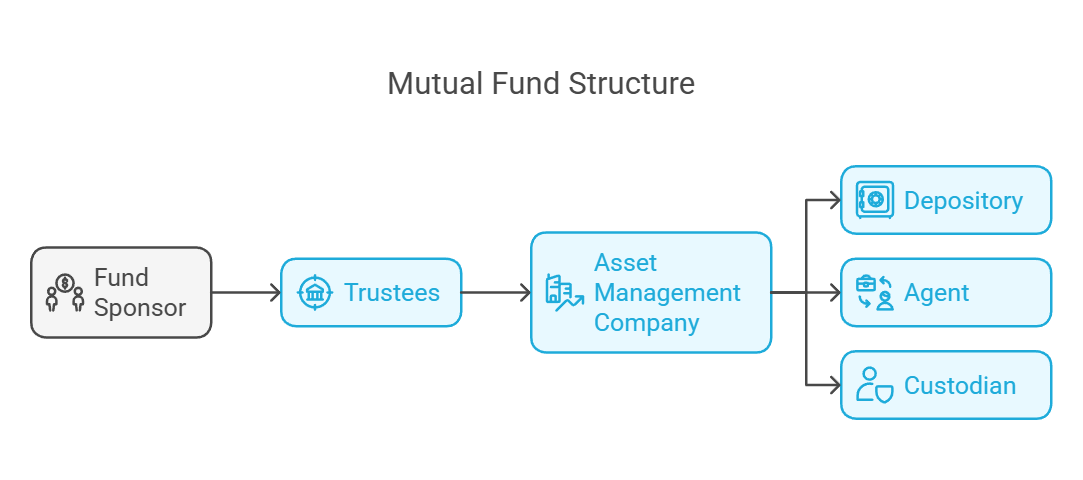Mutual Funds Structure
Mutual funds involve several key participants, each playing a distinct role in their creation, operation, and regulation. Here's a breakdown of the major players:
Financial Asset Management Structure
Depository
Asset Management Company
Fund Sponsor
Trustees
Agent
Custodian
Financial Asset Management Structure
Depository
Fund Sponsor
Asset Management Company
Trustees
Agent
Custodian
Mutual Fund Structure
Depository
Asset Management Company
Fund Sponsor
Trustees
Agent
Custodian
Participants and Their Roles
-
Fund Sponsor:
- Represented by a rectangle on the far left, indicating its role as the initiator of the mutual fund.
- Symbolized by an icon of people and money, signifying its role in bringing together investors' capital.
- Role: The entity that conceives the idea of the mutual fund, establishes the fund, and registers it with the regulatory authorities. It's analogous to the promoter of a company.
-
Trustees:
- Represented by a rectangle in the middle, connected to the Fund Sponsor by an arrow.
- Symbolized by an icon of a building with pillars and a target, representing stability, oversight, and the protection of unitholder interests.
- Role: Appointed by the Fund Sponsor, the trustees hold the fund's assets in trust for the benefit of the unitholders (investors). They are responsible for overseeing the operations of the fund, ensuring it acts in accordance with the trust deed, regulations, and the best interests of the investors.
-
Asset Management Company (AMC):
- Represented by a rectangle to the right of the Trustees, connected by an arrow.
- Symbolized by an icon of a building with a graph, indicating its role in managing investments and growing the fund's assets.
- Role: Appointed by the Trustees, the AMC is responsible for the day-to-day management of the fund's investments. This includes making investment decisions (buying and selling securities), conducting research, and administering the fund's operations.
-
Depository:
- Represented by a rounded rectangle on the far right, connected to the AMC by an arrow.
- Symbolized by an icon of a safe, representing the secure storage of securities.
- Role: Holds the fund's securities in dematerialized (electronic) form, ensuring their safekeeping and facilitating electronic transactions.
-
Agent:
- Represented by a rounded rectangle below the AMC, connected by an arrow.
- Symbolized by an icon of people and a briefcase, representing the intermediary role between the fund and investors.
- Role: Acts as a distributor or broker, selling the mutual fund's units to investors. They may also provide investment advice to investors.
-
Custodian:
- Represented by a rounded rectangle below the Agent, connected by an arrow.
- Symbolized by an icon of a person, representing the entity responsible for safeguarding the fund's assets.
- Role: Holds the physical custody of the fund's assets (securities), ensuring their safekeeping and managing related transactions (e.g., collecting dividends, settling trades).
Flow of Responsibility
The arrows in the diagram illustrate the flow of responsibility:
- The Fund Sponsor initiates the fund and appoints the Trustees.
- The Trustees appoint the AMC to manage the investments.
- The AMC utilizes the services of the Depository, Agent, and Custodian to carry out its functions effectively.
Conclusion
The image provides a clear and concise visual representation of the mutual fund structure. It highlights the key participants – Fund Sponsor, Trustees, AMC, Depository, Agent, and Custodian – and their respective roles in the establishment, management, and operation of the fund. The flowchart format effectively demonstrates the flow of responsibility and the interconnectedness of these entities in ensuring the smooth functioning and investor protection within a mutual fund.
